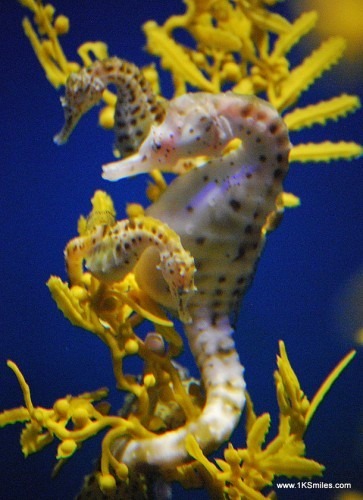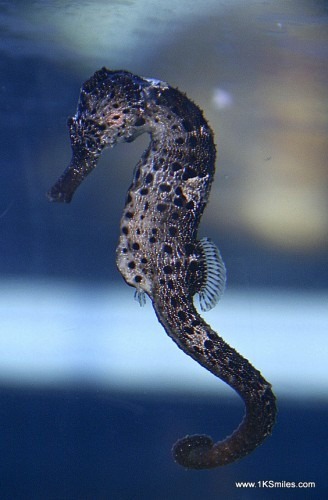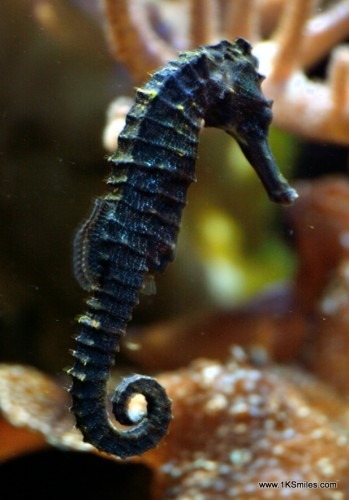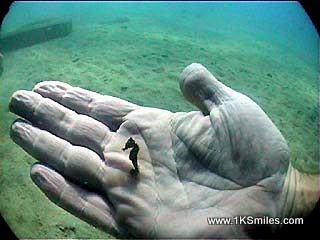According to Wikipedia, seahorse is the name given to 54 species of small marine fishes from the genus Hippocampus which comes from the Ancient Greek hippos meaning “horse” and kampos meaning “sea monster”. I guess that is because it sort of looks like a horse and a monster at the same time?
I love these creatures. They are so amazing looking and always make me smile. I was dreaming one day of having an aquarium of my own with a family of seahorse cruising around but figured that will never happen. They must be super expensive and hard to care for. Not so according to Seahorse.com which tells us that there are three types that are perhaps best-suited for beginners–Pixies, Zulu-lulus and Mustangs. They said Pixies are the smallest of all seahorse available to hobbyists. They are no bigger than your thumbnail and are the easiest seahorses to breed and raise. They are inexpensive (if you consider $250 for a pair inexpensive), hardy, breed like crazy, and a whole herd of this seahorse family will live happily in a simple 5-10 gallon setup.
The seahorse is mainly found in shallow tropical and temperate waters throughout the world and live in sheltered areas such as seagrass beds, estuaries, coral reefs, or mangroves. You should be able to simulate this in a tank. Seahorses range in size from 1.5 to 35.5 cm (0.6 to 14.0 in) and swim very poorly, rapidly fluttering a dorsal fin up to 35 times per second and using pectoral fins which are located behind their eyes to steer. In this way they sort of remind me of the hummingbird and a little like the sea monkey.
AllTheSea.com describes the seahorse as: They have the head of a horse with the snout of an aardvark, spines like a puffer fish, a pouch of a kangaroo, eyes like a lizards, the tail of a monkey, an armor plated body like Stegosaurus, the ability to change colors like a chameleon and to wrap their tails around things. I think that sums it up pretty well don’t you?
The Chinese use the seahorse for medicinal purpose primarily for the treatment of impotence, wheezing, nocturnal enuresis, and pain, as well as to promote labor.
According to National Geographic the male seahorse is equipped with a brood pouch on their front-facing side, or ventral. While mating, the female deposits her eggs, up to 1,500 of them, into his pouch, and the male fertilizes them internally. He then carries the eggs in this pouch until they hatch, then he releases fully formed and miniature seahorses into the water. Pretty cool.
The seahorse anchors itself with its’ prehensile tail to sea grasses and corals, using an elongated snout to suck in plankton and small crustaceans that drift by. They are voracious eaters and will graze continually consuming 3,000 or more brine shrimp per day! This is why many baby seahorse do not survive after birth. They are too small to be distinguished between babies and plankton by the adults.
If you ever see the seahorse in the wild or in a tank somewhere, stop and watch them for a moment or two. I bet they will make you smile as well.
Have you ever seen a live seahorse? Was it in a tank or in the wild? Click here to leave a comment and share your opinion and experience. Would love to hear from you.
please share it with your friends using the Shareaholic buttons below.
buy the DVD:[easyazon_link asin=”B000EZ907K” locale=”US” new_window=”yes” nofollow=”default” tag=”1ksmiles-20″ add_to_cart=”default” cloaking=”default” localization=”default” popups=”default”] Kingdom of the Seahorse[/easyazon_link] by NOVA at Amazon today.
Join biologist Amanda Vincent on a tour of the complex and beautiful world of the seahorse. Travel from an underwater enclave in Australia where their unique mating dance is recorded on camera for the first time, to the bustling apothecary shops of Hong Kong, China, where heaps of harvested seahorses feed a steady market for their medicinal uses.
[easyazon_image add_to_cart=”default” align=”center” asin=”B000EZ907K” cloaking=”default” height=”500″ localization=”default” locale=”US” nofollow=”default” new_window=”yes” src=”http://ecx.images-amazon.com/images/I/51MAHVVAK0L.jpg” tag=”1ksmiles-20″ width=”354″]NOVA – Kingdom of the Seahorse[/easyazon_image]
[easyazon_cta add_to_cart=”default” align=”center” asin=”B000EZ907K” cloaking=”default” height=”28″ key=”small-light” localization=”default” locale=”US” nofollow=”default” new_window=”yes” tag=”1ksmiles-20″ width=”120″]NOVA – Kingdom of the Seahorse[/easyazon_cta]




